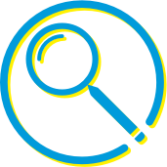November 17, 2017
THIS POST IS PART OF A SERIES.
YOU CAN READ PART 1 HERE.
Hopefully, we have already convinced you to create a forecasting document. Now it is time to go into more detail about how not to create one. We also provide some tips and tricks to make your forecast more accurate and useful.
Tip 1: Use a template so you don’t reinvent the wheel!
In the previous post, we talked about creating probabilities based on the type, tier, and history of the funder. But we do not want you to reinvent the wheel when doing this work. A template can make this process a lot easier, and we’ve provided one that you can download at the end of this post.
Type of Funder
You should classify your funders as either public, corporate, or foundation. Depending on your circumstances, it might also make sense to have a category for family foundation, major donor, or local v. national foundation. In general, public agencies are going to have a lower funding probability than corporate foundations and both will be lower than private foundations. National foundations are going to be much lower than local or regional funders.
Tier or Alignment
Tier should be used to classify funders by how well aligned you are. Obviously, you are more likely to be funded by organizations with which you closely align. Some nonprofits also benefit by classifying funders by which program they support. They know that one of their programs is able to win new funders 10% of the time, while another might only win funding 5% of the time.
History or Relationship
Your probability should obviously be MUCH higher among existing funders. In fact, if you are not renewing over 90% of your existing funders, at least among those who fund annually, you need to examine your stewardship efforts. History can also help you classify funders by your cultivation efforts and how long you have been building a real relationship with them.
Tip 2: All your funders must be named. Prospects AND ‘TBD’ ARE not funderS!
A major problem we see with forecasts is that many people want their projections to yield more money than they do. They frequently add a line for prospects that are not yet identified. Whether you call this TBD or ‘unidentified funders’ or ‘prospects’ — it does not belong on your forecasting chart, and you need to immediately delete that row.
Of course, there is an exception to this rule and it depends on timing. If you’re creating a projections chart for next year just a few months into your current fiscal year, you can have a line for unidentified prospects. If you have included this, you or your development team should ensure your team is actively bringing a lot of prospects to you every few weeks.
However, if you are approving an official projections chart for the upcoming year, there is a small probability that you are going to find new prospects, cultivate them, apply to them, and win first-time funding during that same year.
Tip 3: Expand your list or increase your renewal amounts (NOT your percentages)
If you have elected to set a fundraising goal before looking at your revenue projections, we recommend that you revise your goal after seeing what is possible from your projections.
In particular, please do not arbitrarily fiddle with your projections, percentages, or ask amount to get to your desired fundraising goal. Instead, create a low and high version of your projections, with riskier percentages. (To see a real example of how we did this, make sure to download the free template at the end of this post!)
If your projections still do not reach your goals—again—please do not adjust your projections arbitrarily. Instead, this is your opportunity to see what is missing from your projections and if you need to expand “the top of the funnel” by adding more prospects. You can also look at your renewals and increase the ask amount in order to upgrade them to larger amounts.
Finally, if your projections still are not where you need them to be, you need to adjust your goal downward. It is MUCH better to do the difficult work of limiting expenses now, before you have spent the money, than it is to be mid-way through the year looking at an expense budget that surpasses your revenue projections. You will have less time to cut those expenses, and so the shortfall will actually feel more significant if you wait for six months.
Tip 4: Examine your assumptions and learn as you go!
The goal of your forecast is to predict reality given all the uncertainty there is – so even if you raise a LOT more than you thought you would, your forecast was not as helpful as it should have been.
Much worse, and more common, is if you have projected that you will raise much more than you did. You are likely stressed already and will have to cut major planned expenses.
If you’re new to forecasting, and this has happened, you have to fully examine your assumptions:
- Are you better or worse at cultivating than thought? You can determine this by noticing if what you projected as very unlikely—5% or 10% possibilities—turned out to be funded closer to 20% of the time.
- Were there external things you did not predict but could have – i.e. new government opportunities that became available or former funding streams that were shut down? To predict these better, you can make sure you’re on the right listservs, attending the right coalition or association meetings, and networking with your colleagues to stay in the loop about local and federal funding opportunities.
forecasting isn’t an exact science, but it is a necessary practice.
Estimate on the conservative side, be realistic about your probabilities, and adjust your assumptions as you become more comfortable with your organization’s probabilities for success.
About the Author:

Founder & CEO















